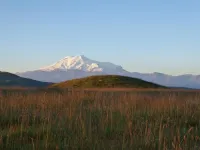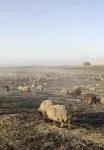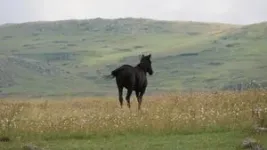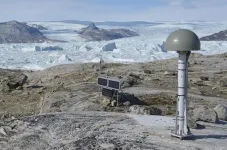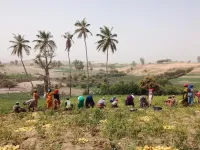(Press-News.org) The wider Caucasus region, between the Black and the Caspian Seas, connects Europe, the Near East and Asia. It displays a huge geographic, ecological, economic, cultural, and linguistic range today, from the steppe zone in the north, the Caucasus mountains in the center, to the highlands of today’s Armenia, Georgia, Azerbaijan and Iran in the south. This diversity was no different in the past, where the archaeological record attests to many different influences from many surrounding regions.
“It is precisely this interface of different eco-geographic features and archaeological cultures that makes the region so interesting to study”, explains Dr. Wolfgang Haak, senior author and principal investigator of the study. “By establishing a time series across many consecutive archaeological periods, we wanted to capture the time periods when, for example, the first farmers arrived in the region, or when the combination of new innovations in e.g., herd management, dairying, and mobility, enabled an autonomous nomadic lifestyle adapted to exploit the vast Eurasian steppe zone”.
The team observes an alternating series of interaction and gene flow between inhabitants of the major eco-geographic zones of the mountainous upland regions and the steppes to the north of the Caucasus. “Initially, we find two distinct genetic ancestries among the hunter-gatherer groups north and south of the Greater Caucasus”, adds lead author Ayshin Ghalichi, PhD candidate at the Max Planck Institute for Evolutionary Anthropology in Leipzig.
This picture changed with the arrival of early farmers from northern Mesopotamia in the 6th millennium BC, which led to two initial processes of mixture: one between these early farmers farmers and Caucasus/Iranian hunter-gatherers, which formed the predominant ancestry south of the Caucasus mountains, and a second one between the aforementioned hunter-gatherer groups, which resulted in the ancestry profile in the steppe zone north of the Caucasus. During the following 5th and 4th millennium BC, Eneolithic cultures emerged in the river valleys of the North-Pontic steppe and became archaeologically visible as they built characteristic earthen burial mounds, known as ‘kurgans’. New Eneolithic groups arriving from the south led to a period of contact and exchange between both groups and resulted in the emergence of the Maykop culture phenomenon in the 4th millennium BC, which represents a horizon of technical and social innovations in archaeology.
Into the great wide open
“This is a peak time of knowledge and technology transfer in the North Caucasus region, when we see very similar cultural elements in genetically different groups, but also many signs of mixing and mingling”, explains Dr. Sabine Reinhold, co-lead author and principal investigator at the German Archaeological Institute in Berlin. “We uncover the moments when groups began to adapt their lifestyle to a more mobile economy, more suitable to the seemingly endless grasslands of Eurasia.” Indeed, the archaeological record attest to critical innovations in herd management, dairying practices, and mobility such as wheels and wagons, of mobile architecture, and the incipient horse domestication, besides many more. “The global dairy industry today is built on the back of these Bronze Age innovations,” says Prof. Christina Warinner, co-author and professor of anthropology at Harvard University. “They turned a somewhat niche practice into a multicontinental phenomenon.”
Durable foodstuffs such as the early forms of cheese, together with innovations in transportation, made it possible to populate the Eurasian steppe permanently and establish continent-wide networks of communication. The combination of innovations paved the way for a fully nomadic pastoralist life-style at the turn the 3rd millennium BC, practiced for instance by groups associated the Yamnaya cultural complex, which soon after expanded across the entire western steppe zone, as far as Mongolia in the east, and the Carpathian Basin in the west. Interestingly, it was also a time when Caucasus groups expanded to the south, such as the Kura-Araxes culture of Georgia, which extended to regions in east Anatolia, the Levante, and Iran, albeit with little or no connections to the steppe zone in the north.
The team also explored the social structure of prehistoric groups by analysing patterns of biological relatedness and consanguinity and found differences between the steppe and the Caucasus groups. The more stationary Caucasus groups showed higher levels of consanguinity and close connections between individuals buried in the same and/or nearby kurgans, whereas the steppe groups revealed very few of such connections, hinting at a different form of social organization of mobile pastoralist groups.
Dissolution and transformation
However, the turn to the 2nd millennium BC represents another period of interaction between the steppe and Caucasus populations. Triggered by a period of aridification and possibly over-exploitation of the ecologically fragile steppe environment and unreliable levels of precipitation, the steppe zone became largely depopulated. The archaeogenetic study finds clear evidence of assimilation and mixture of Caucasus groups, while the resulting Middle and Late Bronze Age groups retreated further into the Caucasus highlands where they established a sedentary mountain economy. This transformation also formed the cultural and genetic basis for the present-day populations of the North Caucasus.
“Our integrated study is a beautiful example of human resilience, adaptability and innovation in the light of ecological, economic and socio-political changes”, concludes Prof. Svend Hansen, director of the Eurasia Department of the German Archaeological Institute, and co-senior author of the study.
END
Into the great wide open: How steppe pastoralist groups formed and transformed over time
Genetic study of the wider Caucasus region shows how movement of people and innovation transfer enabled pastoralists to exploit the steppe zones of Eurasia
2024-10-30
ELSE PRESS RELEASES FROM THIS DATE:
Determining precise timing of cellular growth to understand the origins of cancer
2024-10-30
Cancers are diseases of abnormal cellular growth, and although many are treatable or even curable, their origins are not necessarily clear. Understanding the precise timing of cellular events—as cells transition from normal to cancerous conditions—is key to uncovering new treatments or diagnostic opportunities.
Scientists from Vanderbilt University, led by Mirazul Islam, a graduate student mentored by Professor of Cell and Developmental Biology Ken Lau and Professor of Medicine Robert Coffey, have laid the groundwork for understanding and predicting the natural transition between precancers and cancer. They showed that colorectal cancer is likely to ...
Healthy brains suppress inappropriate immune responses
2024-10-30
The brain constantly engages in dialogue with the body’s immune system. Such communication appears aimed at ensuring a delicate balance between defending against injury and infection and guarding healthy tissue.
Now, scientists at Washington University School of Medicine in St. Louis have revealed how the two strike a healthy balance. The study, in mice, found that fragments of immune-stimulating proteins – dubbed guardian peptides – are produced by the brain and spinal cord of the central nervous system to maintain ...
Large meltwater accumulation revealed inside Greenland Ice Sheet
2024-10-30
A new study published in Nature unveils a surprising discovery: a substantial amount of meltwater is temporarily stored within the Greenland Ice Sheet during summer months. For the first time, an international group of researchers was able to quantify meltwater with positioning data. The finding challenges current models of how ice sheets contribute to global sea level rise.
The Greenland Ice Sheet is currently the largest single contributor to global sea-level rise, with the potential to raise the mean sea level by up to seven meters if it fully melts. While ...
Ancient DNA brings to life history of the iconic aurochs, whose tale is intertwined with climate change and human culture
2024-10-30
Geneticists from Trinity College Dublin, together with an international team of researchers, have deciphered the prehistory of aurochs – the animals that were the focus of some of the most iconic early human art – by analysing 38 genomes harvested from bones dating across 50 millennia and stretching from Siberia to Britain.
The aurochs roamed in Europe, Asia and Africa for hundreds of thousands of years. Adorned as paintings on many a cave wall, their domestication to create cattle gave us a harnessed source of muscle, meat and milk. Such ...
Reversing environmental decline: Lessons from African communities
2024-10-30
In rural Africa, where livelihoods are often tied directly to the land, environmental degradation poses a critical threat to both ecosystems and people’s well-being. New research reveals ways to tackle the dual challenges of land degradation and poverty.
In rural Africa, where livelihoods are often tied directly to the land, environmental degradation poses a critical threat to both ecosystems and people’s well-being. A new study co-authored by researchers at Stanford University and the French Agricultural Research Centre for International Development (CIRAD) analyzes how ...
'Black box' of stem cell transplants opened in world-first blood study
2024-10-30
For the first time, scientists have tracked what happens to stem cells decades after a transplant, lifting the lid on the procedure that has been a medical mystery for over 50 years.
Insights could pave the way for new strategies in donor selection and transplant success, potentially leading to safer, more effective transplants.
Researchers from the Wellcome Sanger Institute and their collaborators at the University of Zurich were able to map the behaviour of stem cells in recipients’ bodies up to three decades post-transplant, ...
New pathway for sensing cold temperatures identified in rice
2024-10-30
A gene called COLD6 contributes to cold tolerance in rice, potentially offering a pathway to use molecular design to breed a rice variety with higher resistance to cold stress. This work appears October 30 in the Cell Press journal Molecular Cell.
“Cold damage is a major challenge in rice production, and identifying key gene modules in signalling pathways is a crucial step in addressing this issue,” says senior study author Kang Chong of the Chinese Academy of Sciences. “Our research focused on uncovering the molecular mechanism behind crops’ response to cold stress. We hope to ...
Study identifies how ovarian cancer protects itself, paves way for improved immunotherapy approach
2024-10-30
New York, NY [October 30, 2024]—Researchers at the Icahn School of Medicine at Mount Sinai have discovered a way that ovarian cancer tumors manipulate their environment to resist immunotherapy and identified a drug target that could overcome that resistance.
The study, published in the October 30 online issue of Cell [DOI: 10.1016/j.cell.2024.10.006], used a cutting-edge spatial genomics technology and preclinical animal models, with tumor specimens from ovarian cancer patients further validating the findings.
The researchers found that ovarian cancer cells produce a molecule called Interleukin-4 (IL-4), which is typically ...
State policies regulating law enforcement access to prescription drug monitoring program testosterone prescription data
2024-10-30
About The Study: This study found that testosterone prescription data through prescription drug monitoring programs was accessible to law enforcement without basic safeguards (such as a warrant or subpoena) in nearly half of states. The ease of access to this sensitive medical information raises privacy, care quality, and civil liberties concerns, especially amid the proliferation of gender-affirming care bans.
Corresponding Author: To contact the corresponding author, Katie McCreedy, MPH, email mccreedy.k@northeastern.edu.
To access the embargoed study: Visit our For The Media website at this link https://media.jamanetwork.com/
(doi:10.1001/jama.2024.20035)
Editor’s ...
Validation of the Kansas City Cardiomyopathy Questionnaire in patients with tricuspid regurgitation
2024-10-30
About The Study: In this cohort study, the Kansas City Cardiomyopathy Questionnaire (KCCQ) had strong psychometric properties in patients with severe tricuspid regurgitation, including reliability, responsiveness, and validity. These data support use of the KCCQ in patients with severe tricuspid regurgitation as a measure of their symptoms, function, and quality of life and also for assessing the impact of interventions, such as transcatheter tricuspid valve intervention, in rigorously controlled trials.
Corresponding Author: To contact the corresponding ...
LAST 30 PRESS RELEASES:
Clearing the brain of aging cells could aid epilepsy and reduce seizures
Brain injuries linked with potential risk of suicide, new study finds
New technique lights up where drugs go in the body, cell by cell
New study finds movement of fishing fleets can reveal shifts in marine ecosystems
Embargoed: New evidence points to potential treatment for vascular dementia
Study uncovers disrupted brain balance in alcohol dependence
Working in groups can help Republicans and Democrats agree on controversial content moderation online
Structural findings reveal how distinct GPCR ligands create different levels of activation
Anything-goes “anyons” may be at the root of surprising quantum experiments
UC review: Maximizing workplace opportunity for veterans
From generation to complex control: Metasurfaces make perfect vortex beams "within reach"
Thin-film lithium niobate-based detector: recent advances and perspectives
Exploring why some people may tend to persistently make bad choices
How cells balance their protein levels
Nirsevimab vs RSVpreF vaccine for RSV–related hospitalization in newborns
Effectiveness and impact of maternal RSV immunization and nirsevimab on medically attended RSV in US children
AI gives scientists a boost, but at the cost of too many mediocre papers
Next-generation vision model maps tree growth at sub-meter precision
Genes aren’t destiny for inherited blindness, study shows
MIT study: High-fat diets make liver cells more likely to become cancerous
Exposure to multiple fine particulate matter components and incident depression in the US Medicare population
Risk of burdensome health care spending over time in the US
Nirsevimab against hospitalizations and emergency department visits for lower respiratory tract infection in infants
New microfluidics technology enables highly uniform DNA condensate formation
A new strategy for immune tolerance
Super Mario Bros. help fight burnout: New study links classic games to boosted happiness
Deepest gas hydrate cold seep ever discovered in the arctic: International research team unveils Freya Hydrate Mounds at 3,640 m depth.
Integrating light and structure: Smarter mapping for fragile wetland ecosystems
ACA-SIM: A robust way to decode satellite signals over complex waters
Probiotics can restore gut microbiome in breastfed infants
[Press-News.org] Into the great wide open: How steppe pastoralist groups formed and transformed over timeGenetic study of the wider Caucasus region shows how movement of people and innovation transfer enabled pastoralists to exploit the steppe zones of Eurasia
